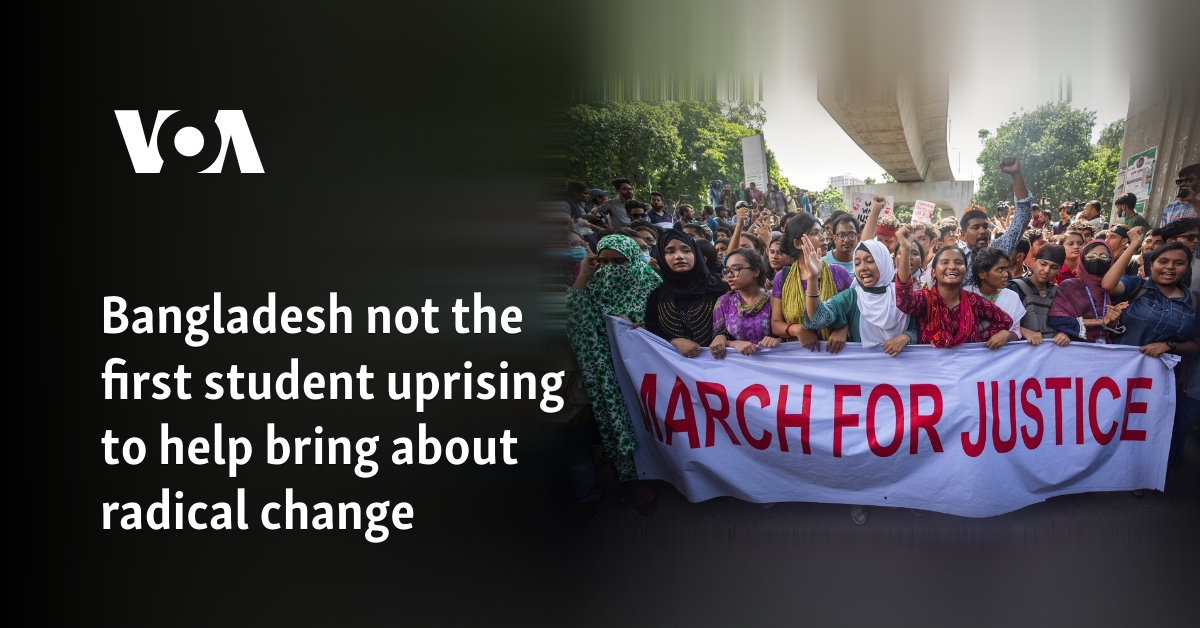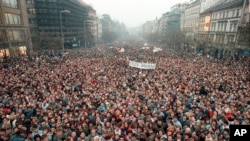In Bangladesh, weeks of protests against a quota system for government jobs escalated into a widespread uprising that forced the prime minister to flee the country and resign.
The demonstrations began peacefully last month and were led mainly by students who were dissatisfied with the system, which they said favored those with ties to the ruling party.
But violence erupted on July 15 as student protesters clashed with security officials and pro-government activists. Former Prime Minister Sheikh Hasina fled this week following the unrest that left nearly 300 people dead, including both students and police officers.
Students or other young people have often played a key role in popular uprisings that have brought down governments or forced them to change their policies. Here are some other important cases:
Gota Go Gama protests in Sri Lanka
As in Bangladesh, Sri Lanka also succeeded in overthrowing a government through large-scale protests in 2022. Young people played a key role in this.
Isolated demonstrations developed into months-long protests starting in March 2022 as the economic crisis in the Indian Ocean island nation deepened, leading to shortages of fuel, cooking gas and other essential goods, as well as a prolonged power outage.
In April, protesters led mainly by university students and other young people occupied an esplanade next to President Gotabaya Rajapaksa’s office in the capital, Colombo, demanding his resignation and that of his government.
Every day more people arrived and set up a tent camp called “Gota Go Gama” or “Gota Go Village,” a play on Gotabaya’s nickname “Gota.”
The protest site was peaceful. Organizers offered people free food, water, toilets and even medical care. The camp’s leaders, many of them university students, held daily press conferences and speeches while the crowd was entertained by bands and plays.
The government responded by imposing a curfew, declaring a state of emergency, allowing the military to arrest civilians and restricting access to social media, but failed to stop the protests.
Under pressure, many ministers resigned, but President Rajapaksa and his older brother, Prime Minister Mahinda Rajapaksa, remained in office.
In May, Rajapaksa supporters attacked the protest camp, sparking widespread condemnation across the country and forcing Prime Minister Rajapaksa to resign.
Gotabaya Rajapaksa held on to power until July, when protesters stormed his official residence and forced him to flee the country. After seeking temporary refuge in the Maldives, Rajapaksa later resigned.
His successor, Ranil Wickremesinghe, in one of his first official acts as the new president, expelled the demonstrators from the occupied government buildings and closed their camp. Their tents were dismantled in the middle of the night.
The situation has now calmed down and Wickremesinghe has been able to address the shortage of food, fuel and medicine and restore electricity.
However, complaints persist over increases in taxes and electricity bills, part of the new government’s efforts to meet International Monetary Fund loan terms. Former Prime Minister Rajapaksa’s son, Namal Rajapaksa, will contest the presidential election in September this year.
Uprising at the Athens Polytechnic in Greece
In November 1973, students of the Polytechnic University of Athens rose up against the military junta that had ruled Greece with an iron fist for more than six years.
In a coup in 1967, military officers seized power and established a dictatorship characterized by the arrest, exile and torture of their political opponents.
The brutality and harshness of the regime led to growing opposition, especially among students, which culminated in the November Uprising.
The protest began peacefully on November 14, when students at the Polytechnic University of Athens staged a strike and occupied the campus. The next day, thousands from the Athens area joined the students in support, and demonstrations grew, as did calls for an end to the dictatorship.
On November 17, the military crushed the uprising when a tank crashed through the university gates in the early hours of the morning, killing several students. The death toll is still disputed, but at the time the regime had reported 15 deaths.
A few days after the uprising, another military officer staged a coup and imposed an even harsher regime. However, this did not last long, as a series of events led to the return of democracy in Greece, the birthplace of democratization, in 1974.
A prosecutor’s report published after the return of civilian government estimated the death toll at 34 but named only 18. There were over 1,100 injured.
Even today, the annual marches in Athens to commemorate the pro-democracy student uprising attract thousands of people.
Demonstrations at Kent State in the United States
American students had long been protesting against U.S. involvement in Vietnam when President Richard Nixon authorized attacks on neutral Cambodia in April 1970, escalating the conflict to disrupt enemy supply lines.
On May 4, hundreds of students at Kent State University in Ohio gathered to protest the bombing of Cambodia. Authorities called in the Ohio National Guard to disperse the crowd.
After failing to disperse the protest with tear gas, the National Guard advanced and some opened fire on the crowd, killing four students and injuring nine others.
The confrontation, also known as the May 4th Massacre, was a defining moment for a nation deeply divided by the protracted conflict in which more than 58,000 Americans died.
This sparked a strike by 4 million students across the United States, which led to the temporary closure of around 900 colleges and universities. The events also played a crucial role in turning public opinion against the conflict in Southeast Asia, according to historians.
Soweto uprising in South Africa
In the decades-long struggle against the rule of the white minority in South Africa, a turning point occurred in 1976 in the Johannesburg district of Soweto.
In a series of demonstrations that began on June 16, black students from several schools took to the streets to protest against the requirement to teach in Afrikaans, the Dutch-derived language of the white rulers who designed the system of racial oppression known as apartheid.
The protests spread to other parts of South Africa and became a flashpoint of anger at a system that denied the country’s black majority adequate education, voting rights and other basic rights.
It is estimated that hundreds of people died in the government crackdown that followed.
One symbol of the bloodshed was the photo of dying student Hector Pieterson. The image of his limp body being carried by another teenager went around the world and spurred international efforts to end racial segregation in South Africa, even though apartheid was to continue for nearly two decades.
South Africa achieved democracy through majority elections in 1994 and today June 16 is a national holiday.
Velvet Revolution in Czechoslovakia
As the communist governments of Eastern Europe began to falter in 1989, large demonstrations broke out in Czechoslovakia after riot police broke up a student protest in Prague on November 17.
On November 20, as anti-communist protests grew, the students were joined by dozens of others and about 500,000 people took to the streets of Prague.
The protests were also called the “Velvet Revolution” because of their non-violent nature and led to the resignation of the Communist Party leadership on November 28.
On December 10, Czechoslovakia had a new government, and on December 29, Václav Havel, a dissident playwright who had spent several years in prison, was elected the country’s first democratic president in half a century by a parliament still dominated by communist hardliners.
In 1992, Czechoslovakia was peacefully divided into two countries: the Czech Republic and Slovakia.


